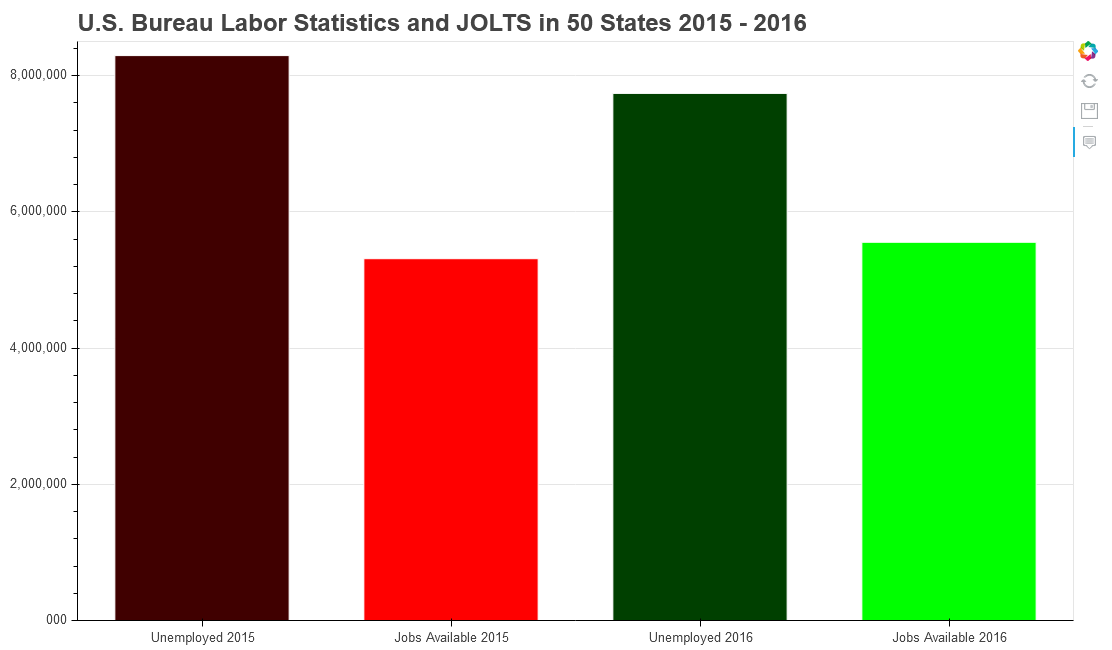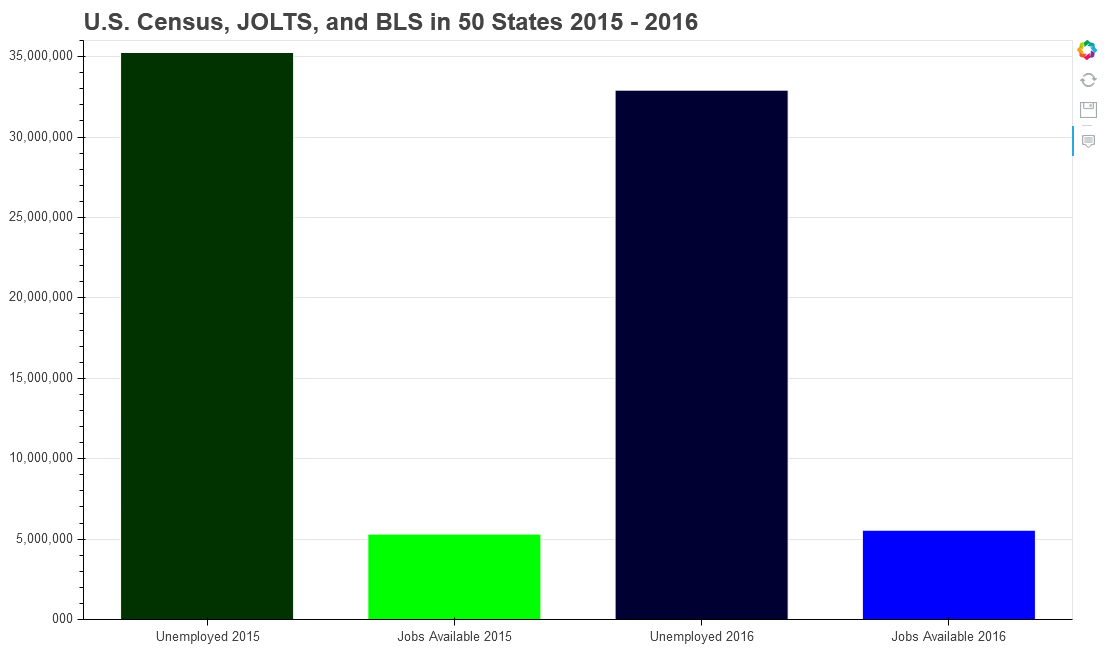According to the Bureau Labor of Statistics and Job Opening and Labor Turnover estimates in 2016, of the 7,738,000 unemployed, 2,185,5001 did not have an open position available to them. This estimate is less than 2015, when 2,981,834 unemployed people apparently did not have a job available to them.
BLS stats2 note an age restriction of 16 and older. To identify if retirees are included in the BLS stats, the Census population estimates by age and state was analyzed.
Removing the BLS Employed and Institutionalized3 population from the Census estimates reveals a much larger portion of the population without a job available to them. According to Census, BLS, and JOLTS data estimates, of the approximately 32,913,191 unemployed population about 27,360,691 people did not have an open position available to them in 2016.
Check out the interactive regional BLS and Census Maps here.
Jupyter notebook pages reveal a regional breakdown of the BLS and Census stats on a map for both years. Estimates for whether or not stay-at-home parents are considered employed or unemployed vary by state.
According to Scott Galloway, Professor of Marketing at the NYU Stern School of Business, the job scarcity estimates revealed by this analysis may be attributed to Amazon reducing jobs in retail and other industries. Source: The Four
Nevertheless, to-date I do not have an official answer as to how fast automation is reducing available jobs.
Manual steps to recreate results:
- Download the Census dataset here or look for the data named "Annual Estimates of the Civilian Population by Single Year of Age and Sex for the United States and States: April 1, 2010 to July 1, 2016".
- Filter Census data by years, state, and ages 16-67.
- Grab table one from the Bureau Labor of Statistics Data website.
- Filter by years and regions: Northeast, West, South, Midwest
- Get the Job Opening and Labor Turnover stats here.
- Filter by years, seasonally adjusted and all job categories, data comes in regions
- Download cphalpert's handy census-regions algorithm
- Add Census stats by region
- Reduce BLS Unemployed by JOLTS Available Jobs for both years
- Get institutionalized population estimates by reducing BLS Pop estimates by CLF
- Take regional Census data and reduce by BLS institutionalized and employed population
- Remaining number is estimate of unemployed population, subtract JOLTS available jobs for estimates used in graphs.
Project Dependencies
- Python or an Interpreter
- Jupyter Notebooks
- Bokeh
JOLTS data
Information collected from 16,000 randomly selected nonfarm establishments, drawn from a universe of approximately 8 million establishments compiled as part of the Quarterly Census of Employment and Wages, or ES-202, program.
This code JTS000000NEJOL is used in the JOLTS dataset to seperate stats by region, industry, and seasonal.
- JT = series_id
- S = seasonally adjusted (compensates for seasonal employment/taking job elsewhere due to weather, taking additional job for holidays, etc.)
- 000000 = industry_code (all non-farm including private sector)
- NE = region_code (Northeast)
- JO = dataelement_code (Job Openings)
- L = ratelevel_code (L is level meaning data is in a four digit number representing thousands)
BLS stats Population, Civilian Labor Force, Employed, Unemployed, Institutionalized Data
- Official national estimates obtained from Current Population Survey (CPS)
- Sample survey of households conducted for Bureau of Labor Statistics (BLS) by U.S. Census Bureau
- LAUS measures employed and unemployed based on place-of-residence basis
- Did any work for pay/profit
- Worked 15+ hours w/o pay in a family business or farm
- Not working currently on temporary or absent condition, regardless of whether or not paid
- Not working looking for work/available for work
- Currently laid off
- Population 16 years of age and older
- Not an inmate of the following institutions: penal, mental facilities, home for the aged, or not on active duty.
- Data accounts for the 10,827,000 disabled population unable to work between the ages of 16-64.

